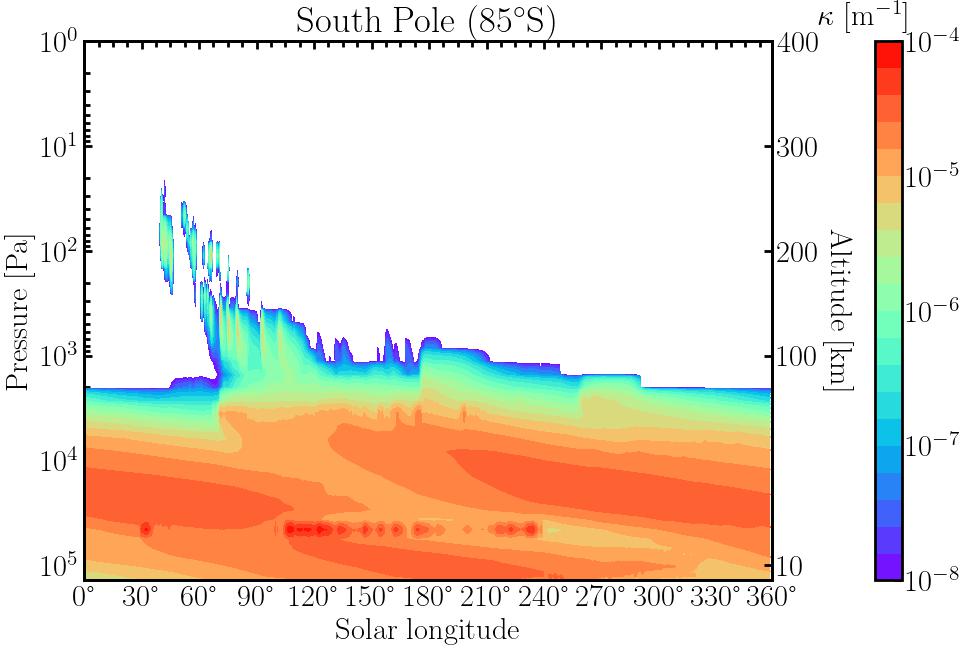Microphysics of Titan's clouds: constraints on their structure, formation and transport.
- 1Groupe de Spectrométrie Moléculaire et Atmosphérique, Université de Reims Champagne-Ardenne, Reims, France (bruno.de-batz-de-trenquelleon@univ-reims.fr)
- 2Laboratoire de Météorologie Dynamique, Sorbonne Université, Paris, France
1. Principle of the work
On Titan, as on Earth, a wide variety of clouds form from various processes and conditions. Unlike our planet, clouds on Titan emerge from a variety of volatile compounds. Observations have shown several types of cloud, such as convective clouds of methane, stratiform clouds of ethane, or high-altitude clouds containing compounds like HCN and HC3N. In addition, a large high-altitude HCN ice cloud was discovered in May 2012, formed in the polar vortex at the South Pole [1]. Generally, convective methane clouds are found at the summer pole and mid-latitudes, while other types of cloud are observed at the winter pole. Despite the various observations made by Cassini and Huygens between 2004 and 2017, we still have a limited understanding of the couplings between the different cycles that take place on Titan (haze, clouds, gas, etc.).
The Titan Planetary Climate Model (Titan PCM), first developed at the Institut Pierre-Simon Laplace, is the ideal tool for understanding how these cycles work and how clouds form on Titan. The transition of the model into three dimensions has considerably improved our knowledge of the mechanisms of Titan's middle atmosphere [2]. The microphysical processes associated with haze were implemented in the Titan PCM a long time ago, and we now have adapted and implemented a microphysical model to simulate the processes associated with clouds of CH4, C2H2, C2H6 and HCN [3]. We plan to include convective aspects in forthcoming studies. These are phenomena that have not yet been simulated in Titan's 3D climate models, in particular the nucleation and condensation of methane clouds, which are responsible for much of Titan's cloud cover.
2. Results & Discussion
In this presentation, we propose to use a microphysical cloud model, integrated into the Titan PCM, to study the formation and evolution of hydrocarbon clouds throughout the Titanian year. We will analyse the thermal structure of the model, enabling the formation of the HCN cloud observed at around 300 km. Particular attention will be focused to the methane cycle, including its sources, sinks and associated processes. We will also look at the microphysical properties of the clouds and the constraints on the parameters influencing their formation. The results of the model (Figure 1) will then be compared with existing observations.

Fig. 1 Zonal average of the clouds extinction at 0.7 μm at the South Pole. The extinction above 100 km corresponds to clouds of HCN, while the extinction below is associated with C2H2 and C2H6 clouds. Peaks of extinction between 10 km and 20 km correspond to CH4 clouds. The altitude scale on the right axis is approximate.
This project is in line with previous research aimed at providing answers to persistent questions and deepen our understanding of Titan's atmosphere. The model will be used to interpret future observations of the JWST, as well as preparing for the future Dragonfly mission, by better characterising the expected climate in its landing region.
3. References
[1] R. de Kok, N. Teanby, L. Maltagliati, P. Irwin, and S. Vinatier, “HCN ice inTitan’s high-altitude southern polar cloud,” , vol. 514, no.7520, pp. 65–67, 2014.
[2] S. Lebonnois, J. Burgalat, P. Rannou, and B. Charnay, “Titan global climate model: Anew 3-dimensional version of the IPSL Titan GCM,” ,vol. 218, pp. 707–722, 2012.
[3] J. Burgalat, P. Rannou, T. Cours, and E. D. Rivière, “Modeling cloud microphysics using a two-moments hy-brid bulk/bin scheme for use in Titan’s climate models:Application to the annual and diurnal cycles,” , vol. 231,pp. 310–322, 2014.
How to cite: de Batz de Trenquelléon, B., Rannou, P., Lebonnois, S., and Burgalat, J.: Microphysics of Titan's clouds: constraints on their structure, formation and transport., Europlanet Science Congress 2024, Berlin, Germany, 8–13 Sep 2024, EPSC2024-845, https://doi.org/10.5194/epsc2024-845, 2024.